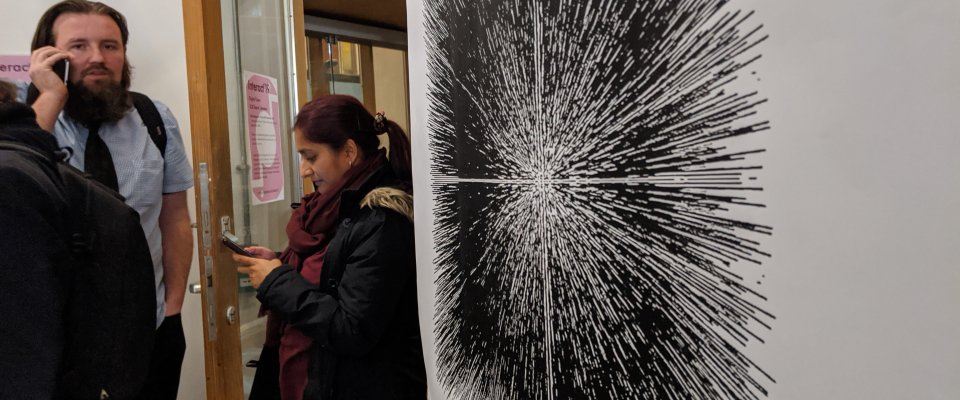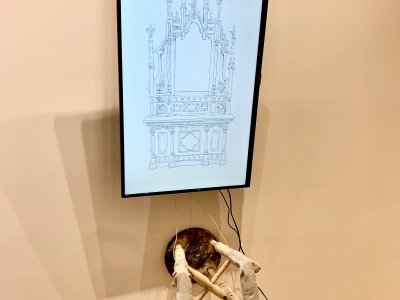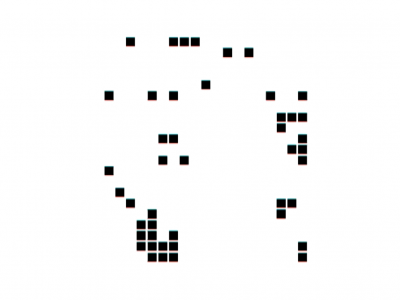Interact'19 Digital Open

Wednesday 4th - Friday 20th December 2019 @ LCB Depot, Leicester
Following the success of last year's Interact'18 show, Interact Digital Arts is hosting another exhibition showcasing the work of digital artists based in Leicester and the surrounding area. Interact'19 features invited and submitted work and includes a live event on Friday 20th December. FREE.
Dave Everitt & Fania Raczinski - "880" (2019)
This algorithmically-generated work shows three interpretations of the complete set of 880 order 4 magic squares (matrices where the numbers of each row, column and diagonal give the same total when added). The middle panel lists every unique permutation of the 16 numbers that can form 4 by 4 magic squares. In the left panel, a straight line connects each number in the sequence, with no space between the squares to merge the image into a single mesh of vectors. The right panel shows each square separately, with curved lines connecting the 16 numbers of each square. No sequence is repeated. The resulting patterns reveal hidden properties.
The oldest datable order 4 magic square was documented by Indian polymath Varahamihira around 587 CE, and in the doorway to the 8th-century Jain temple at Khajuraho in Madhyar Pradesh there is the first known 'most-perfect' order 4 magic square. In Western art the magic square first appears in Dürer's 1514 engraving 'Melencolia I'.
https://daveeveritt.org/art.html
https://dr.physics.wtf
Sean Clark - "Elements 23112019" (2019)
Elements 23112019 is a series of 4096 (8x8x8x8) unique colours generated using a pseudo-random number generator. The colours are then organised according to a set of sequencing rules and presented as collections of 16 four-colour "elements". These elements will be forming the basis of my next set of generative of artworks.
You can explore the full set of elements by scanning the QR Code next to the works, or entering the web address artthings.io/elements into your mobile phone web browser.
Ernest Edmonds - From Sydney (One) (1999)
Ernest Edmonds was born in London in 1942. He now lives in the Peak District and in Sydney Australia. He has pioneered the field of computational art and contributed to the broader field of contemporary art from the late 1960s to the present.
Fabrizio Poltronieri - "Visual Theogonies" (2014)
Fabrizio Poltronieri is an award-winning computer artist, designer, researcher, writer and curator with international experience and a special interest in the relationships between Art, Design, Digital Media, Gamification, and Technology.
https://www.fabriziopoltronieri.com
Thierry Miquel - "Like Like" (2019)
An irreverent look at social media and the pervasive desire for acceptance.
http://graff.io/collections/thierry-miquel
AR Enhanced with the Graff.io Arts AR App for iPhone.
Tom Junker AKA Pauser - "Aruba" (2019)
Tom Junker AKA Pauser is a busy man. A writer since '96 and part of the Czech BFAMBOYS crew, he takes part in street art festivals across the world. When he is not writing or being a dedicated father and husband, he is an accomplished UI designer.
AR Enhanced with the Graff.io Arts AR App for iPhone.
Paul Rudman - "You Are My Sunshine" (2019)
Framed manipulated photograph with proximity-related lighting.
Telemachus2131 - "Ulysses 31: Shirka" (2019)
Shirka is the Odyssey's computer from Ulysses 31, a French-Japanese animated television series (1981).
This piece was realised by manipulating computer-generated waveforms in space and time, combining algorithmic processing from the computer with human participation being basic parameter control. The use of randomised blend and overlay modes as part of the video treatment has resulted in a naturally generated 'lo-res' aesthetic.
The sound was created using algorithmic generation of sound waves with numerous random LFOs (Low-Frequency Oscillators) shaping frequency and amplitude of sound waves. Recordings were edited to create a soundscape eliciting a response grounded in sci-fi, space exploration, light-speed, wormholes and hyperspace.
Visuals were captured from recordings of Ripple Gen which were blended together through a timeline using random algorithms, then added to the sound work relying on natural syncopation for overall arrangement.
"Ripple Gen App uses a sine function to displace vertices in a polygon mesh. The resultant images can then be orientated in 3D space in order to change their perspective. Choosing different parameters for the sine function can result in a wide variety of patterns, shapes and textures." – Jim Frize (Ripple Gen App creator)
Interact'19 Live
Live music and visuals from artists in the exhibition and associates.
Johnny McJohnston - "Digital Stills" (2019)
Digital stills of an audio reactive Max/MSP patch working in realtime, the patch takes an input from any audio source and translates the data visually, the stills capture and frame the dynamic and sometimes chaotic movements in a single moment of reference. The images portray the digital representation of the analogue world as seen through a computer.
James Chantry - "Necromancy" (2019)

This work considers queer spectrality, phantasmagoria and the supernatural. Mediumship and the literary ghost story, pose coded historical context of queer identity and repression. Victorian Mediums, such as Daniel Dunglas Home, known for his intimate relationships with men whom attended his seances, would 'materialise spirit hands and feet.' A modern medium is contrasted, within this artwork, set in a liminal and remote landscape, mainstays of the 'Ghost Story'. A Lincolnshire Radar station becomes perhaps: a church, a theatre.
James Chantry is a contemporary artist, he has exhibited in London, Edinburgh, Leicestershire, Yorkshire, Taiwan and China. He is a PhD candidate at De Montfort University, in Fine Art by practice. His practice explores the links between the literary and media arts genre of horror, and queer identity. Utilising fragments of heritage to form a symbiotic relationship. He produces installation work through drawing, sound and interactive technologies.
In recent work the literary ghost story is utilised as a thematic framework, and specific geographic locations. In particular queering liminal wildernesses, such as fenland and the edge lands between city and countryside. His aim is to create new worlds from the past, that consider: identity politics, psychogeography, supernatural, science fiction and history, in a queer and hauntological context.
Mateus Domingos - "Meander 1" (2019)
Printed grid of images captured from web-based work that uses javascript to generate a randomly shifting meander form rendered in ASCII style characters. The work continues an exploration of language, text and meaning.
Jim Tetlow - "The Beauty of Wisdom" (2019)
Figurative abstract making use of the chance element within certain digital techniques. Originating in 2004, further developed in 2009 and 2019.
Will Horspool - "Dreams of Venus" (2019)
The Venus of Hohle Fels is made from mammoth ivory and could be up to 40,000 years old. Here it is reimagined using algorithms capable of "artistic style transfer" using images from great master painters like Van Gogh, Gustav Klimt and Wassily Kandinsky.
https://www.facebook.com/AIAIOMG/
Leila Houston - "The Grey Area" (2019)
Over the last 18 months, Leila Houston has been researching the music box and automata and looking at how the 'chimes' can be related back to a time when people would call out the time of day to farmers far and wide in a field, dictated by a sundial or water timer. She has incorporated influences from both newer technologies and the older technologies they descend from. Leila uses analogue, digital, traditional art forms and participation to create the work.
In the installation, The Grey Area will ask the audience to select options relating to one or more of their concerns about the current political system and their own well being. Data will be collected from their selections through touch. Following the election, on the 12th the data will be translated into a sound piece and a further artwork shown in the final week of the Interact'19 exhibition.
http://leilahoustonart.weebly.com
Sabotage - "Untitled" (2019)
"Today the tyrant rules not by club or fist, but disguised as a market researcher, he shepherds his flocks in the ways of utility and comfort." - Marshall McLuhan
https://www.instagram.com/sab_o_teur
https://www.jassingh.org
Leonie DuBarry-Gurr (2007)

XIMGSND01 / XIMGSND02
Portrait photographs are pixellated, with each pixel translated into a musical note using the colour data contained within each pixel.
In XIMGSND01 the notes are defined using the percentage of the colour black within each pixel of a grayscale image. The film is a result of animating the pixels from left to right, with every pixel containing the same percentage of black shown on screen at the same time. If pixels contain the same value of black in succession the assigned note is sustained until the next change in black percentage.
In XIMGSND02 (aka A portrait of you and me) the notes (sung by the people in the portraits - and played simultaneously) have been 'programmed' using the same method, where a colour value in a pixel is translated into a musical note. The film is animated to visualise the composition.
Land & Sea : A madrigal on 'R'
Musical notes were determined using the percentage of red (R) within the pixels of two photographs - one of land, one of the sea. The photographs are 'played' simultaneously - the colours shown in the film are the colours of the pixel that is relative to the note. This work was hand-drawn and made for television.
IN THE BEGINNING
Starting with the original text written in Hebrew (with an alphabet where each letter has a relative number), Genesis Chapter 1 is both visually and audibly translated. The numbers associated with the letters in the Hebrew text coincide with a certain colour and musical note - these colour blocks and notes are then 'played' in a hand-drawn animation.
These works are artist-generated using data available within chosen parameters; animated, composed and performed by a human (inspired by computer processing).
















































